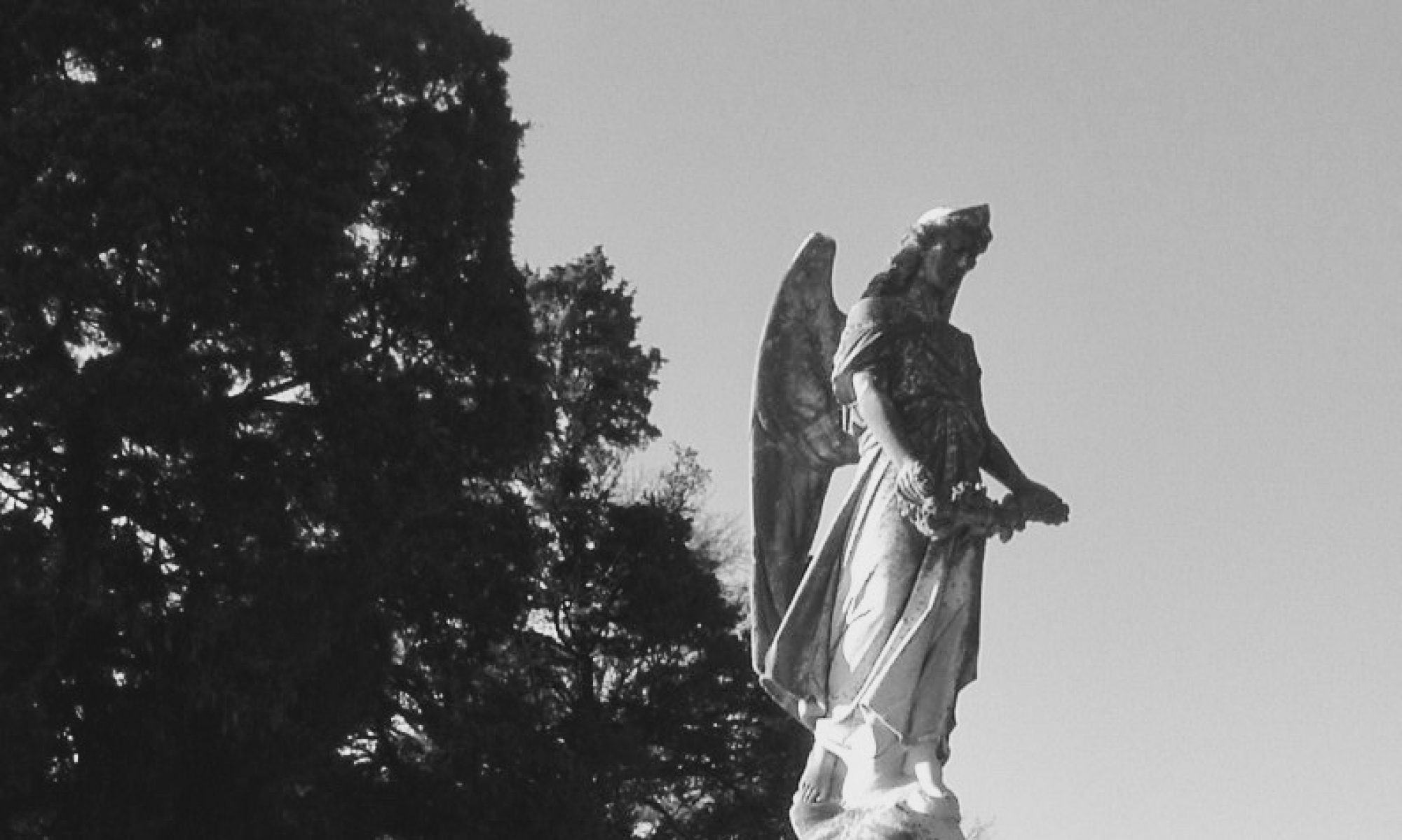The Georgia state line to Smyrna
Tennessee’s most celebrated haunting is the tale of the Bell Witch. For a period of about four years—from 1817 to 1821—the family of John Bell living on the Red River in Robertson County was plagued by a mysterious and mischievous entity. While the hauntings are supposed to have died down in 1821, paranormal activity has persisted in the area that is still ascribed to the famous “witch.” It is through this area, now the town of Adams, where US 41 passes a short distance from the Bell family’s former property.
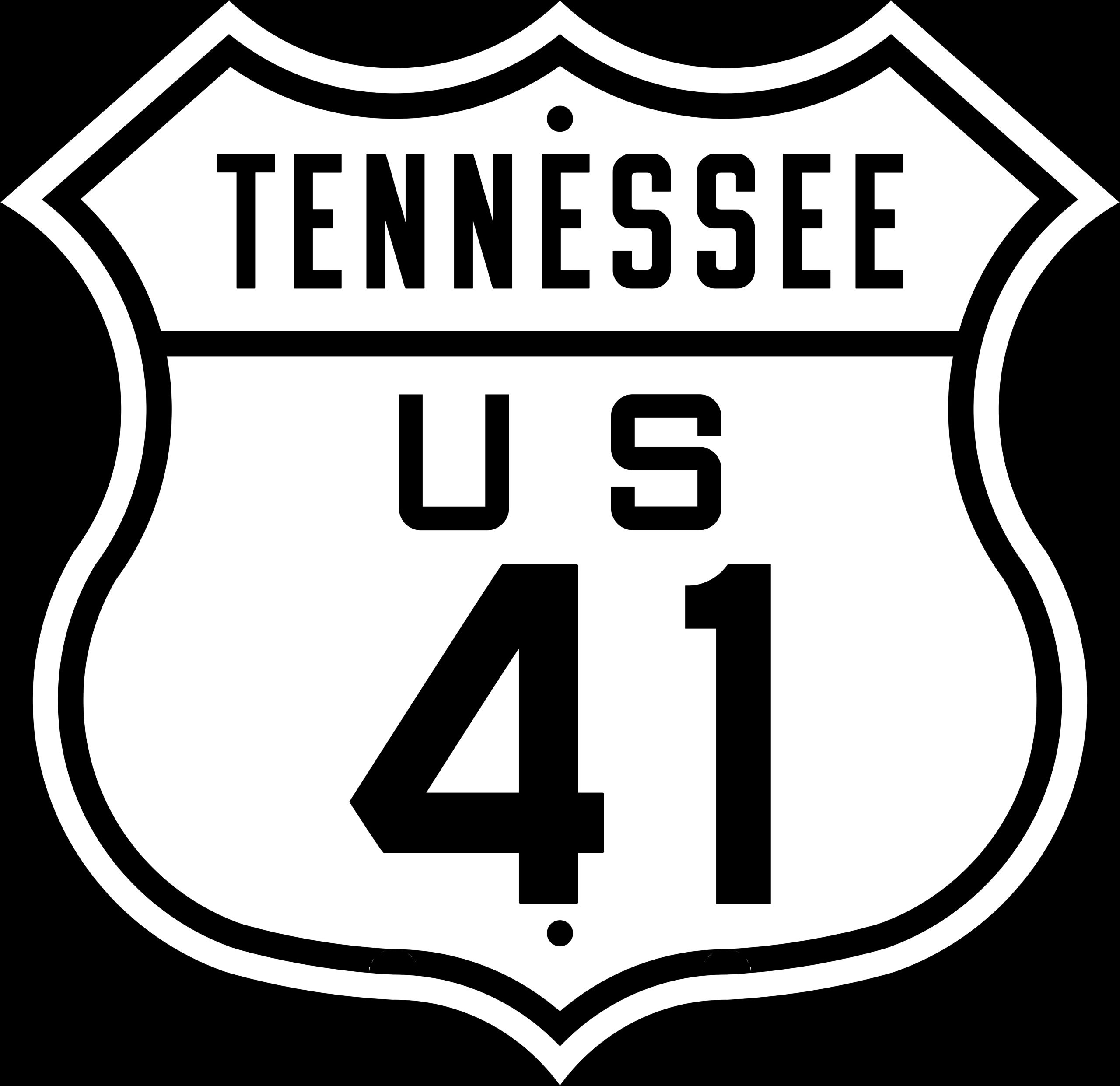
US Route 41 cuts diagonally through Middle Tennessee from Chattanooga across the Cumberland Plateau through Murfreesboro and Nashville to cross over the state line into Guthrie, Kentucky. Part of this route was established around 1915 with the creation of the Dixie Highway which ran from Sault Ste. Marie, Michigan south to Miami, Florida. This portion of the Dixie Highway was designated as US 41 in 1926, with the announcement of the original numbered highway system. While the road has been supplanted by I-24 throughout Tennessee, this highway provides a much more scenic, and haunted, route through the state.
This article explores US 41 from where the road crosses the Georgia state line into East Ridge and Chattanooga, to Smyrna in Rutherford County just before the road passes into Davidson County and Nashville. Part II of this article will cover the remaining portion of the route from Nashville to the Kentucky state line.
East Ridge
Southeast of downtown Chattanooga, US 41 crosses into Tennessee from Georgia into the city of East Ridge.
Mount Olivet Cemetery
Mount Olivet Drive
Located on a hill above the busy rush of US 41, Mount Olivet Cemetery provides an attractive and peaceful oasis from the hustle below. With graves dating to the mid-19th century, this Catholic cemetery also possesses some spectral residents. According to investigator and author Mark E. Fults, he and a friend saw several specters during a late-night walk of this burial ground some 30 years ago. At one mausoleum, the pair saw “a petite, waif-like woman peering sadly through the barred windows.”
At another mausoleum, the investigators witnessed what Fults describes as “ectoplasm.” “There was a faint phosphorescent green mist directly up against the barred windows with images forming within it. As we watched, a hand appeared and then dissolved into the mass of energy. When a watchful eye materialized, we both were gripped with a sickening ache to the solar plexus…we backed away thoroughly nauseated and eager for fresh air.” Fults reports that his friend “was sick for days afterwards, as the energy tried to possess him.”
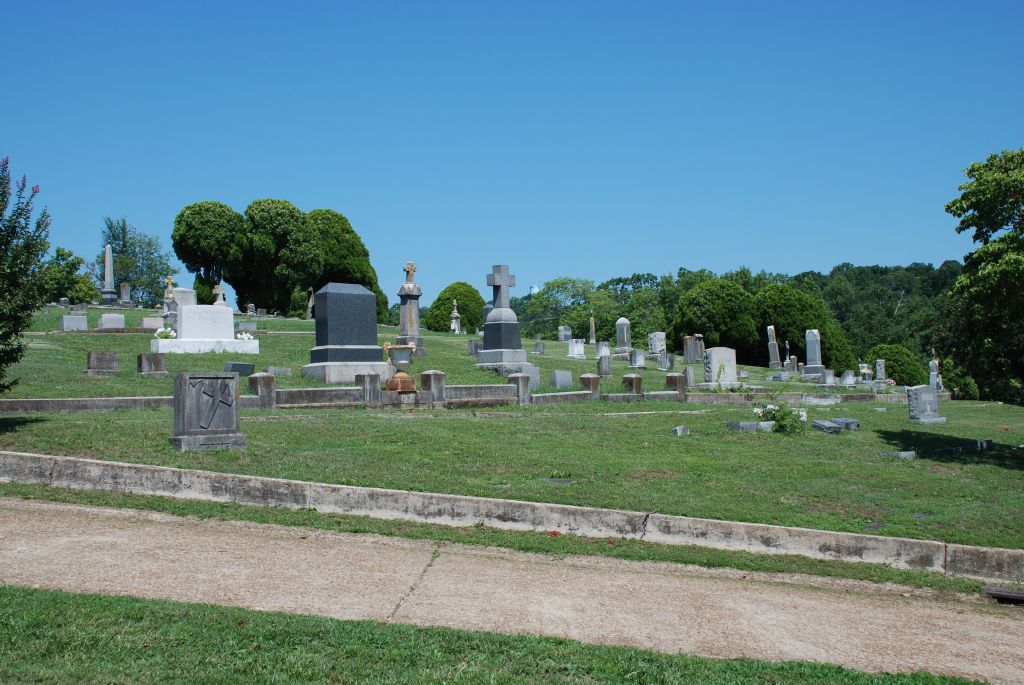
After viewing this ghostly light show, the friends saw a large, black dog observing them from the edge of the woods. As they toured the cemetery, this dog was hiding behind monuments and trees and scurrying between them on two legs. Fults believes this was a watcher spirit keeping vigil over the dead who rest here.
Please note, this cemetery is active and well-maintained. Late night investigations are discouraged, and such a visit would likely be considered trespassing by the local authorities.
Sources
-
- Fults, Mark E. Chattanooga Chills, Second Edition. Mark E. Fults, 2012.

The passage into Chattanooga is made through the Bachman Tunnels, which were bored through Missionary Ridge in the late 1920s, opening officially in 1929. While there are no published ghost stories regarding these nearly one-hundred-year-old tunnels, I suspect that there is probably some mysterious activity associated with them.
Chattanooga
Tennessee’s fourth largest city, Chattanooga is situated on the banks of the Tennessee River at Moccasin Bend. Archaeological excavations have revealed that humans have lived in this spot for millennia. Prior to the arrival of Spanish conquistador Hernando de Soto in 1540, the area was a major center for Mississippian culture. In the historic era, the area came under control of the Cherokee People.
White settlers began to filter into the area in the 1830s displacing the native people and creating Ross’ Landing on the river near present day downtown. As they were removed in 1838 on the Trail of Tears, many Cherokee People stopped here before continuing towards the west. As the settlement grew, the town became an important center of river commerce. The introduction of the railroad brought more settlers and strategic importance to the city. The outbreak of the Civil War brought military activity here and the city was captured by Union troops in 1863 after several major battles were fought in the area, including the Battle of Chattanooga, the battle of Lookout Mountain, and the Battle of Chickamauga.
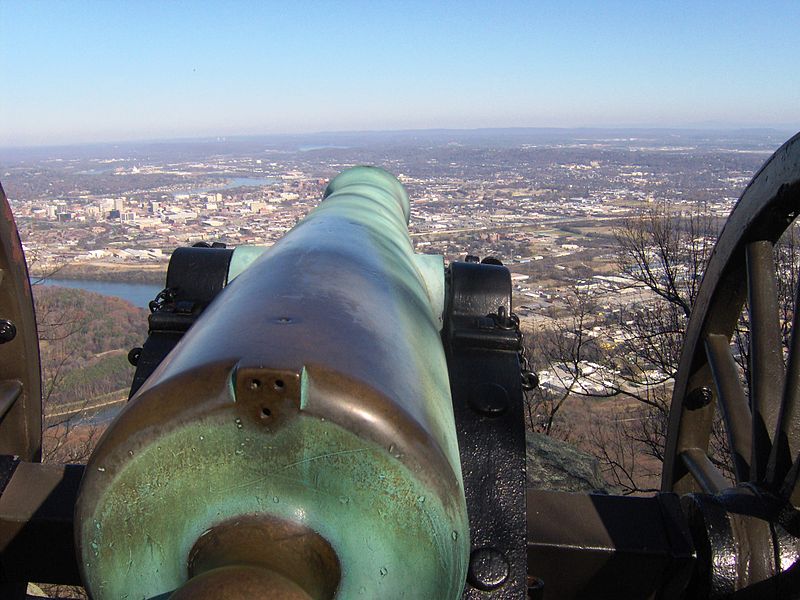
As a result of Union attention during the war, the city became quite industrialized during the latter part of the 19th century. As many of the industries began to move elsewhere towards the middle of the 20th century, the city began to clean up its pollution and remake itself as a tourist town. Today, all of these layers of history have left spiritual marks in terms of ghosts and hauntings.
Sources
- Ezzell, Timothy P. “Chattanooga.” Tennessee Encyclopedia. 8 October 2017.
Passing into Chattanooga, US 41 runs along West Main Street before turning south onto Broad Street. Downtown, there are a number of hauntings, many of which are featured on the Chattanooga Ghost Tour (see my review here). Among the sites where one might find paranormal activity are the Chattanooga Public Library, Engel Stadium, the Hamilton County Jail, and the Southside Saloon and Bistro.
After turning onto Broad Street, US 41 runs concurrent with US 11 (the Lee Highway), US 64, and US 72 along the Tennessee River at the base of Lookout Mountain. The site of heavy fighting during the Civil War Battle of Lookout Mountain, the flanks of the mountain are dotted with haunted places including Ruby Falls Caverns.
Still running parallel to the Tennessee River, US 41 passes near Raccoon Mountain Caverns, a short distance outside of Chattanooga.
Raccoon Mountain Caverns
319 West Hills Drive
Tradition holds that locals were first drawn here by a cool breeze blowing up through rocks on the grounds of the Grand Hotel Farm in the 1920s. Local caver and entrepreneur Leo Lambert, who incidentally discovered and developed Ruby Falls Caverns, was tipped off about the possible existence of a cave and began exploring it in 1929. After finding the cave’s famous Crystal Palace Room with its dramatic and impressive formations, he immediately set about opening the cave to tourists. In 1931, Tennessee Caverns opened to serve the tourist traffic from US 41. Later, the cave was renamed Crystal City Caves later and other attractions were added at the cave’s entrance including a sky bucket ride called the Mount Aetna Skyride.

On the night of November 30, 1966, 39-year-old Willie Cowan, the attraction’s night watchman was killed in a fire that destroyed the skyride, as well as the cave’s ticket office and gift shop. In the years since his death, his spirit has been sensed within the cave and the rebuilt gift shop and ticket office. Many guides passing through the cave have smelled Cowan’s cigar smoke, heard his whistling, and several have glimpsed his figure on the route of the cave tours. While touring the cave, author Amy Petulla saw a light during a moment where the lights were turned off to provide visitors with the experience of pitch darkness. The spirit appears to be fairly active around the anniversary of Cowan’s death.
Sources
-
- Matthews, Larry E. Caves of Chattanooga. Huntsville, AL: The National Speleological Society, 2007.
- Penot, Jessica and Amy Petulla. Haunted Chattanooga. Charleston, SC: History Press, 2011.
Haletown
Just before the road dips south to cross the Tennessee River in Haletown, it passes the now infamous Hales Bar Dam.
Hales Bar Dam
1265 Hales Bar Road
Located on a sand bar extending into the Tennessee River, Hales Bar Dam was constructed to provide hydroelectric power to the area. This sand bar is part of a 33 mile stretch of river made dangerous by a number of whirlpools, so the dam’s construction also included a lock on the river to improve navigation. Work commenced in 1905 and was initially expected to last up to two years. When the dam remained incomplete after two years of work, the first contractors withdrew from the project. Another contractor was selected the following year and construction of the power house, the main surviving element of the dam, was begun. Difficulty with the foundation of the structure led to numerous budget overruns and problems for work crews. Despite the issues, however, the dam was completed and began operation in 1913.
Fissures in the structure’s limestone bedrock and innumerable leaks led to a host of issues plagued the dam as it continued to operate over the proceeding decades. In the early 1960s, the Tennessee Valley Authority (TVA) made the decision to abandon it once construction of the Nickajack Dam was completed to the south. Parts of the dam’s facilities were demolished in the years following, though the power house has remained as a main feature of the Hales Bar Marina.
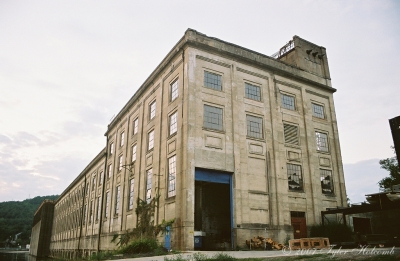
Over the past couple decades, the abandoned dam has attracted the attention of paranormal investigators who have discovered that it is now the residence of spirits. That attention has led to investigations by television paranormal teams from the shows Ghost Hunters and Ghost Adventures who have all walked away with tremendous evidence. During filming for an episode of Zak Bagans’ Ghost Adventures in 2011, a sudden storm erupted damaging part of the marina and several boats and vehicles. Bagans presumed that the sudden storm was another manifestation of the curse of Chief Dragging Canoe, which is sometimes blamed for local paranormal activity, though there seems to be little evidence to support this correlation.
The dam is haunted by a variety of spirits ranging from children to shadow people to a former dam foreman. Investigators have reported hearing footsteps, voices, and many EVPs have been captured within the structure and throughout the surrounding marina.
Sources
-
- Archambault, Paul. National Register of Historic Places nomination form for Hales Bar Dam. 30 May 2008.
- Glover, Greg. “Weather provides new twist for Ghost Adventures.” 28 February 2011.
- Phipps, Sean. “An overnight paranormal investigation of Hales Bar Dam.” com. 12 March 2017.
After crossing the Tennessee River in Haletown, US 41 continues through Jasper and heads towards Monteagle.
Monteagle
Located at the meeting point of three counties—Grundy, Marion, and Franklin–the town of Monteagle is situated on the Cumberland Plateau. It was on the edge of this plateau that John Moffat, an organizer in the temperance movement, bought a huge tract of land in 1870. In 1882, the Monteagle Sunday School Assembly was created here. This organization, built on the ideas of the Chautauqua Movement, was founded to promote the “advancement of science, literary attainment, Sunday school interest and promotion of the broadest popular culture in the interest of Christianity without regard to sect or denomination.” The assembly constructed buildings throughout town to support and house the masses of people attending and who continue to be drawn to this city on the edge of the Cumberland Plateau.
Sources
- Turner, William Ray. “Grundy County.” Tennessee Encyclopedia. 8 October 2017.
- Wills, Rudy, II. “Monteagle Sunday School Assembly.” Tennessee Encyclopedia. 8 October 2017.
“Monteagle Mountain” Stretch of I-24
Goin’ down Monteagle Mountain on I-24
It’s hell for a trucker when the Devil’s at your door
He’ll tempt you and tell you, “Come on, let her roll,
‘Cause the mountain wants your rig, and trucker, I want your soul.”
–Thomas Richard McGibony, “Monteagle Mountain,” released by Johnny Cash on his 1990 album, “Boom Chicka Boom.”
The notoriety of this stretch of interstate highway has garnered the attention of a Johnny Cash song. The song tells the story of a long-haul trucker carrying a load from Nashville to Florida dreading traversing the infamous road around Monteagle. As he starts down the steep grade, his brakes fail, and he is forced to steer the big rig into one of the runaway truck ramps. After stopping on the ramp, and realizes he is alive, and grateful to God “’cause when there’s a runaway on Monteagle, some truckers don’t survive.”
For decades, truckers and other drivers dreaded this scenic, but treacherous section of I-24 just before and after the town of Monteagle. Truckers traversing the steep grade sometimes had their brakes go out and more than a few went hurtling off the mountain highway. Despite improvements by the state’s Department of Transportation, drivers still fear the road.
Historically, the path of the interstate was deemed US 41 dating back to the road’s incorporation as the US numbered highway system, with this stretch dating to the earlier Dixie Highway.
In his 2009 book, Ghosts of Lookout Mountain, Larry Hillhouse includes an oft-told tale from this infamous stretch. As young drivers sometimes eased their trucks down the mountain, some encountered a strange sight. Hillhouse explains that “suddenly a figure appeared in the middle of road. The figure was a man, dressed in light blue overalls and wearing a black cowboy hat, and he was always waving his arms furiously, as if to flag them down.” The drivers downshifted to another gear before realizing there was yet one more hairpin turn that they had to navigate. Having already downshifted, the driver avoided certain danger. Of course, the figure that warned them by darting into the road was nowhere to be seen.
These young drivers would tell an assembled group of older truckers who might nod knowingly and tell them that they had seen the spirit of old Cowboy Lewis. They would explain that he was an unlucky trucker who had lost his life at that curve many years ago and had been buried at that spot. If you happen to decide to test out your vehicle’s brakes on this treacherous terrain and you see the cowboy hat wearing figure dart in front of you, heed his warning, there is a dangerous curve ahead.
Sources
-
- Hillhouse, Larry. Ghosts of Lookout Mountain. Weaver, IA: Quixote Press, 2009.
- Monteagle Mountain. Wikipedia, the Free Encyclopedia. Accessed 31 July 2022.
- “New I-24 lanes opened at Monteagle.” The Tennessean. 12 July 1989.
US 41 enters the town of Monteagle from the east and becomes Main Street for a short distance before heading north. Just before it becomes Main Street, the highway passes the massive DuBose Conference Center.
DuBose Conference Center
635 College Street
Constructed for the DuBose Memorial Church Training School, an Episcopalian seminary, this Mission style structure has provided lodging and facilities for theological students and later visitors visiting the retreat center for almost a hundred years. Over those years, this building may have acquired several spirits as well.
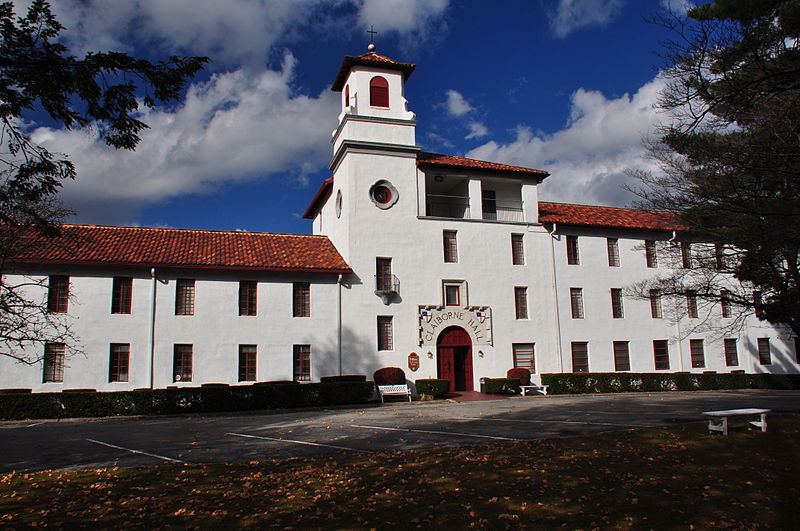
Author Annie Armour documents the experiences of a few visitors here in her book, Haunted Sewanee. One guest witnessed a fog creep into her room in the middle of the night. Slowly, the fog began to form the shape of a young woman who eventually took a seat in a rocking chair and started rocking. The guest watched until the fog faded, though the chair continued rocking for some time. Armour interviewed the daughter of the center’s executive director who would sometimes find herself in the building alone. In those moments, she heard the sounds of footsteps and doors opening and closing, despite the fact that she was entirely alone within the huge facility.
Sources
-
- Armour, Annie. Haunted Sewanee. CreateSpace Publishing, 2017.
- Casteel, Britt. National Register of Historic Places nomination form for the DuBose Conference Center. 15 August 1990.
Edgeworth Inn
19 Wilkins Avenue
According to authors Robert and Anne Wlodarski, the spirit haunting this 1896 home turned bed and breakfast is called “Uncle Harry.” The home was one of the many “cottages” constructed for the Monteagle Sunday School Assembly. This entity is reported to have been active as far back as the 1930s, when he once flipped a punch bowl during a reception. Decades later, as a team from the Travel Channel was filming in the inn, Uncle Harry levitated a plastic punch bowl and set it down on the head of a producer. This mischievous spirit has been accused of showing his displeasure whenever changes are made within the building.
Sources
-
- Wlodarski, Robert James and Anne Powell Wlodarski. Dinner and Spirits: A Guide to America’s Most Haunted Restaurant, Taverns, and Inns. Lincoln, NE: iUniverse Publishing, 2000.
Passing out of Monteagle, the road continues northwest into the town of Manchester, the seat of Coffee County.
Manchester
Manchester City Cemetery
West High Street

Some years ago, a reporter from the local Manchester Times had an eerie experience in the city cemetery following an evening candlelight tour. He wrote in the paper a few years later, “As we neared the end of the presentation and moved to the newer part of the cemetery, I was stopped by what seemed like the voices coming from a nearby group. There was, however, no group near us. The sounds were faint and at the same time seemed right behind me. Still, I couldn’t pin down any particular direction they were coming from. Later I asked my wife and she too had heard something strange but hadn’t wanted to mention it.”
Sources
-
- Coffelt, John. “Haunted Manchester: Times readers details some of the spookiest sites in the area.” Manchester Times. 31 October 2018.
Old Stone Fort State Archaeological Park
732 Stone Fort Drive
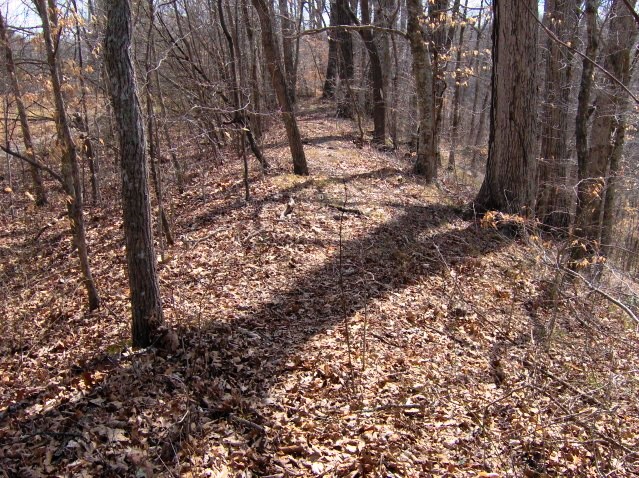
As US 41 leaves Manchester, it passes by Old Stone Fort State Archaeological Park. This state park preserves an ancient Native American site with stone structures and earthworks built at the confluence of the Duck and Little Duck Rivers. The Manchester Times reports that a visitor to the park after hours under a full moon heard the sound of a person running through an open field. The visitor stood there listening to the strange sound, though they did not see anyone around. As the sound passed them they felt a slight breeze.
Sources
-
- Coffelt, John. “Haunted Manchester: Times readers details some of the spookiest sites in the area.” Manchester Times. 31 October 2018.
- Old Stone Fort (Tennessee). Wikipedia, the Free Encyclopedia. Accessed 17 July 2022.
In Rutherford County, the road enters the Nashville Metropolitan area of which Murfreesboro is now the largest suburb.
Murfreesboro
Now the sixth-largest city in the state, Murfreesboro dates its beginnings to the late 18th century when Colonel William Lytle provided land to build a public square, cemetery, and a Presbyterian church. The town was chartered by the state legislature in 1811 and was deemed the county seat of Rutherford County. A few years later, the first courthouse was built in the center of the public square. This building served as the state capitol for nearly a decade until the capitol was moved to nearby Nashville.
Three battles fought here during the Civil War brought national notoriety to the small town. The second of those battles, the Battle of Stones River fought on New Year’s Eve 1862 until January 2, 1863, brought death and devastation to a huge area north of town. In the 1920s, a small percentage of this battlefield was designated by the National Park Service as a military park. The park is in two portions on both sides of US 41, just north of downtown.
Murfreesboro remained a busy center of trade into the mid-20th century. As Nashville has sprawled beyond its limits, the city has developed as a suburb. In the 1990s, much of that development was centered on land around the battlefield park, making this battlefield one of the most endangered in the country. As this dark and bloody ground has been developed, residents and the employees of businesses built here have reported paranormal activity.
Sources
- Huhta, James K. “Murfreesboro.” Tennessee Encyclopedia. 8 October 2017.
Historic Rutherford County Courthouse
Public Square
The first courthouse in the center of Murfreesboro’s Public Square was constructed in 1813. It was in this building that the state legislature met for nearly a decade after the town was deemed the state capital. That first building was replaced after fire destroyed it in 1822. The current building replaced the second courthouse and dates to 1859. During its lifetime it has witnessed a tremendous panoply of history play out within its walls and on the square surrounding it.
During the Civil War, hostilities found their way to the halls of the building as Confederate forces under General Nathan Bedford Forrest raided the Union-occupied town. On July 13, 1862, the Union-occupied courthouse was quickly surrounded by rebel troops who eventually broke their way through the doors. With soldiers from Company B of the 9th Michigan trapped on the upper floors, soldiers from the 1st Georgia Cavalry started a fire to smoke out the Yankees. Trapped, the Michigan soldiers surrendered, and Forrest’s successful raid became a feather in the general’s cap.
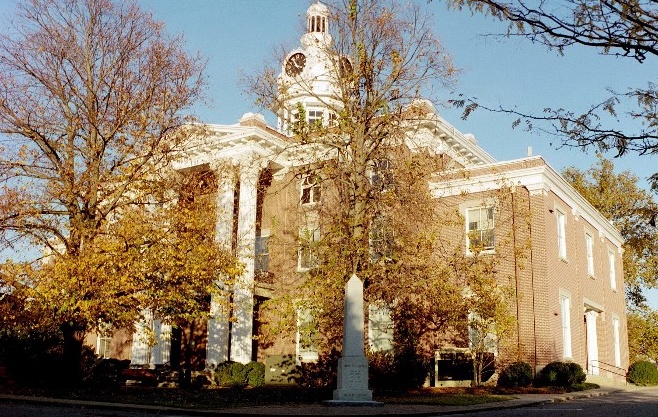
During the Union occupation of the city, the courthouse lawn saw several executions as military leaders tried to contain the rebellious local population and deal with Confederate spies and informants. Later, locals lynched a 19-year-old African-American man here in 1881. Houston Turner was arrested for an attack on a white woman and was being transported to Nashville by the county sheriff when the entourage was surrounded by a mob demanding the prisoner be turned over to them for justice. The sheriff, seeing no alternative, turned him over to the mob who immediately exacted “justice” by hanging him on the courthouse lawn.
Another death occurred here in 1923 when a vaudeville actor billing himself as “The Human Fly” attempted to free-climb the building. After reaching the top of the cupola to the delight of the assembled crowd, the man fell as he began his descent, landing on the roof and breaking his neck.
With so many contentious deaths and an accidental one, plus serving as the focus of more than a century of county history, it’s no surprise that specters continue to rove the antebellum halls and grounds of the courthouse. Over the years, county employees in the building have described physical interactions with spirits that sometimes throw books from shelves, upend furniture, open and close doors, push the living, or play with the elevator. One sensitive investigator reported that the spirit of a lonely young Confederate soldier held her hand. The young man had died within the courthouse during a time when it served as a makeshift hospital and sought comfort from the living investigator. Outside the building, people visiting and working in the businesses surrounding the square also deal with spirited activity that may possibly stem from their proximity to the courthouse.
Sources
-
- La Paglia, Peter S. National Register of Historic Places nomination form for the Rutherford County Courthouse. 10 May 1973.
- Rennick, Lee. “4 haunted places in Murfreesboro.” Rutherford County Source. 28 October 2021.
- Sircy, Allen. Southern Ghost Stories: Murfreesboro: Spirits of Stones River. Amazon Kindle, 2020. eBook.
Big B Cleaners
7 South Public Square
When it comes to places that are likely to be haunted, I’m certain that a dry cleaners would be last on most people’s list. Though, in Murfreesboro, a city rife with history and hauntings, even the cleaners has paranormal activity. Situated on the Public Square facing the haunted Historic Rutherford County Courthouse, the business occupies a pair of old commercial buildings that were home to a furniture store, a saloon, a shoe store, and a theater at varying points in the past. A dry cleaners opened in number 7 in the late 1950s and expanded into number 9 sometime later.
It has been rumored for many years that Big B Cleaners is haunted. In fact, employees called in a paranormal investigative team some years ago to pinpoint the reason why they were dealing with activity. During the investigation by the Shadow Chasers of Middle Tennessee, the group captured EVPs and a pair of investigators saw a shadowy figure on the second floor. “All of a sudden, hair started rising up, and I saw a black figure. He was dark. As a matter of fact, he was darker than the dark. He was going back and forth looking at me. I asked my friend if she saw him, and she said she did.” The pair surmised that the figure tended to stay in a corner of the building and that it may be the spirit of a former owner.
Sources
-
- Sircy, Allen. Southern Ghost Stories: Murfreesboro: Spirits of Stones River. Amazon Kindle, 2020. eBook.
- Willard, Michelle. “Haunting history in Murfreesboro.” The Murfreesboro Post. 30 September 2012.
Oaklands Historic House Museum
900 North Maney Avenue
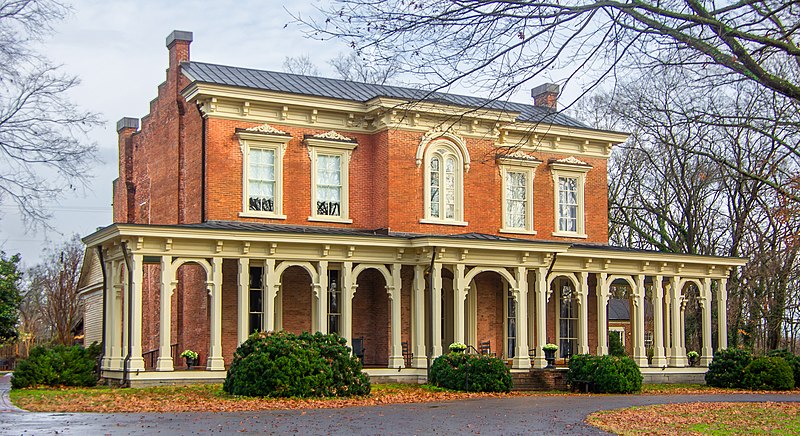
Occupied by the prominent Maney family for almost a century, Oaklands began as a simple two-room structure in the early 19th century. Over time, family members added rooms and renovated older sections to create the large home that stands today. During General Forrest’s raid on the town in July of 1862, a skirmish was fought on the front lawn. The family later opened their home to care for the wounded from the Battle of Stones River. When the home faced demolition in the late 1950s, a group of local women saved it and it now serves as a house museum and event space. Visitors and staff in the house have experienced paranormal activity here since the home’s restoration. Disembodied footsteps, voices, and apparitions of the home’s spectral occupants have been reported.
Sources
-
- Coop, May Dean. National Register of Historic Places nomination form for Oaklands. 9 June 1969.
- Morris, Jeff; Donna Marsh and Garrett Merk. Nashville Haunted Handbook. Cincinnati, OH: Clerisy Press, 2011.
- Sircy, Allen. Southern Ghost Stories: Murfreesboro: Spirits of Stones River. Amazon Kindle, 2020. eBook.
Stones River Country Club
1830 Northwest Broad Street (US 41)
According to author Allen Sircy, who has exhaustively catalogued haunted places throughout the Nashville area in a number of recent books, the clubhouse of the Stones River County Club has paranormal activity. Founded in 1946, as the Town and Country Club and later renamed Stones River Country Club, the club occupies property where fighting occurred during the Battle of Stones River. A local legend speaks of the spirit of a nurse that has been seen in the area who may allegedly haunt the clubhouse. Sircy reports that an employee told him that a woman working with the banquet staff saw “a woman in an old-timey dress…multiple times in the ballroom.”
Sources
-
- Sircy, Allen. Southern Ghost Stories: Murfreesboro: Spirits of Stones River. Amazon Kindle, 2020. eBook.
Bombshells Hair Studio
803 North Thompson Lane #105A
The Gateway Village development hosts a variety of commercial enterprises and businesses, including Bombshells Hair Studio, and occupies a section of the old battlefield. According to Allen Sircy, this hair salon and parts of the development are haunted.
In the twelve years the salon has been open, the owner, her stylists, and employees have experienced a plethora strange activity. The shop’s security system detected much of that activity in the first few months the business was open. The owner was frequently summoned to the shop very early in the morning after the system registered that doors were open or that there was motion inside the building. Staff and patrons have seen the image of a dark-haired women who is known to sometimes grab people.
The spirit is blamed for opening and closing doors, odd sounds, and breaking electrical equipment here. One night, the usually mischievous spirit was helpful when a stylist left a candle burning at her station. When the owner tried to set the alarm before she left, the panel noted that there was an issue with an unused back door. When she went to look at the door, she discovered the candle and extinguished it. After that, there were no further problems setting the alarm. The owner told Allen Sircy, “I think they were trying to warn me.” While the identity of this spirit has not been established, perhaps she is the nurse that is thought to haunt the Stones River County Club.
Sources
-
- Sircy, Allen. Southern Ghost Stories: Murfreesboro: Spirits of Stones River. Amazon Kindle, 2020. eBook.
Stones River National Battlefield
3501 Old Nashville Highway
A Haunted Southern Book of Days–2 January
This article is a part of an occasional blog series highlighting Southern hauntings or high strangeness associated with specific days. For a complete listing, see “A Haunted Southern Book of Days.”
In his memoirs of the Civil War, Private Sam Watkins of the First Tennessee Infantry wrote of the Union’s pyrrhic victory at Stones River, “I cannot remember now or ever seeing more dead men and horses and captured cannon all jumbled together than that scene of blood and carnage…the ground was literally covered with blue coats dead.”
On New Year’s Eve 1862, forces met along the West Fork of Stones River where they fought for control of the town of Murfreesboro. Union forces under General William Rosecrans and Confederate forces under General Braxton Bragg battled for three days with casualties of more than 10,000 men killed, wounded, captured or missing on each side.
Today, about 15% of the battlefield has been preserved by the National Park Service, though much of the remaining battle-scarred land has been developed leaving paranormal activity in homes, businesses, neighborhoods, and commercial developments throughout the area. See above entries.
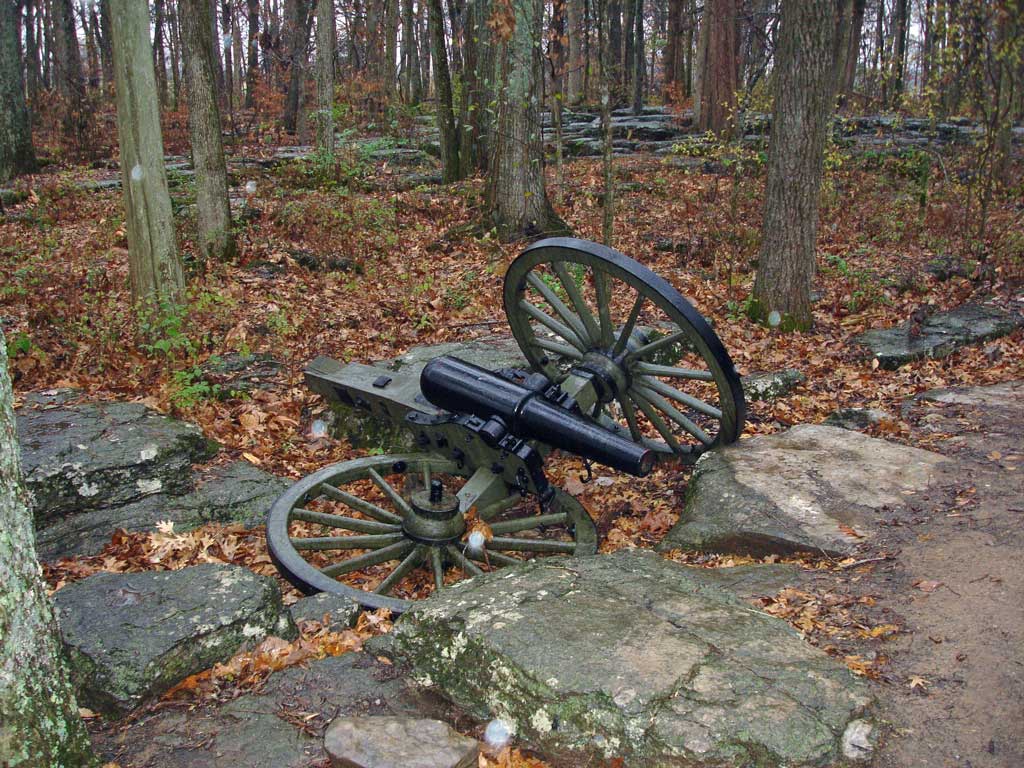
On the preserved portion of the battlefield, there are two primary morbidly-named paranormal hotspots: the Slaughter Pen and Hell’s Half Acre. Battlefield tour stop #2 is the Slaughter Pen where Union soldiers under the command of General Philip Sheridan held out on the first morning of the battle despite suffering tremendous losses. The terrain consists of limestone rocks that form natural knee- and waist-high trenches. Throughout the area visitors have encountered shadow figures, apparitions, strange feelings, and spectral sounds that have been heard amongst the wooded stone outcroppings.

Fighting near what is now tour stop #5, led this section of battlefield to be deemed Hell’s Half Acre. Just six months after the battle, the Hazen Brigade Monument was constructed here, and it remains the oldest Civil War monument in existence. Like the rest of the battlefield, this area is paranormally active and haunted by a headless horseman. During the battle, Union General Rosecrans’ chief of staff, Lt.Col, Julius Peter Garesché was decapitated by a Confederate cannonball while riding his horse near the Round Forest. His spirit continues to ride the battlefield with his head missing. (see my article “‘The most gallant gentleman’–The Headless Horseman of Stones River.”
Sources
-
- Blue & Grey Magazine. Guide to Haunted Places of the Civil War. Columbus, OH: Blue & Grey Magazine, 1996.
- Bush, Bryan and Thomas Freese. Haunted Battlefields of the South. Atglen, PA: Schiffer, 2010.
- McWhiney, Grady. “Stones River, Tennessee.” in The Civil War Battlefield Guide, 2nd Kennedy, Frances H. editor. Boston: Houghton Mifflin, 1998.
- O’Rear, Jim. Tennessee Ghosts. Atglen, PA: Schiffer, 2009.
- Sircy, Allen. Southern Ghost Stories: Murfreesboro: Spirits of Stones River. Amazon Kindle, 2020. eBook.
North of Murfreesboro, US 41 passes through Smyrna and La Vergne before crossing the county line into Davidson County and Nashville proper.
Smyrna
Sam Davis House
1399 Sam Davis Road
On November 27, 1863, Union authorities marched 21-year-old Sam Davis to gallows they had erected in Pulaski, Tennessee. On his birthday, this young man bravely faced death as a Confederate spy. In the intervening years, the young man has been deemed a Confederate hero and martyr while his home has been designated as a shrine and preserved as it was when the young man willingly marched off to certain death.

Within the home, visitors and staff have heard the sounds of weeping. Others have encountered the apparitions of Davis’ mother and grandmother. These active spirits have become known for causing mischief within the home. Staff members and visitors alike have noted that the property is permeated with the spirits of Davis, his family, and their enslaved people.
Sources
-
- Morris, Jeff; Donna Marsh and Garrett Merk. Nashville Haunted Handbook. Cincinnati, OH: Clerisy Press, 2011.
- Ong, Linda. “Spirits still linger at Smyrna’s Sam Davis Home.” 31 October 2019.
- Whittle, Dan. “Spirits make presence known at Sam Davis Home.” Murfreesboro Post. 13 October 2014.
Join me for the rest of this haunted journey along US 41 in Part II as I explore Nashville to the Kentucky state line.
